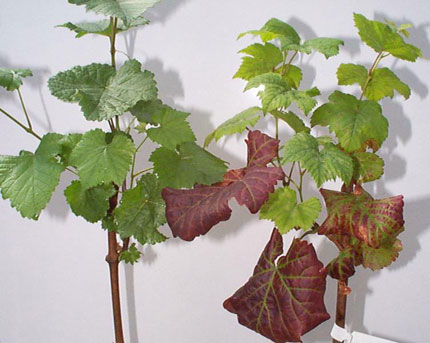From apples and peaches to the grapevines that are the foundation of an internationally respected wine industry, fruit is big business in Canada — close to $900 million in farm cash receipts in 2012 alone.Footnote 1
Fruit is also a major export commodity. In 2012, Canada exported nearly $800 million in fresh, frozen, dried and processed fruit to countries around the world.Footnote 2
Staying competitive, managing risk

Healthy grapevine (left) and plant with Grapevine leafroll virus.
Source: CFIA-Centre for Plant Health
To remain competitive in the global marketplace, Canadian fruit growers work constantly to improve both the quality and the size of their harvest. Innovation often involves importing new varieties from other countries, creating a risk of also importing diseases that could have a serious impact on the industry. The plum pox virus for example, attacks fruits such as peaches, plums, apricots and cherries. An estimated $65 million has been invested in efforts to detect and eradicate the virus since it was first detected in Canada in 2000.Footnote 3 Footnote 4
To protect fruit and other agricultural crops from this and other diseases, Canada has strict regulations that govern the import of plants of all kinds. While Canada accepts plants from certified disease-free sources in other countries, plants from non-certified sources must be tested for disease before they can be grown in Canada. In addition, random testing is carried out on plants from certified sources.
This testing is a major undertaking. At the Canadian Food Inspection Agency (CFIA) Sidney Laboratory in British Columbia, up to 1,500 samples of grapevines alone are tested every year. Anna-Mary Schmidt, head of grapevine diagnostics at the lab, says the testing process is slow and labour-intensive.
Testing can take time—lots of it
"While we do molecular testing, we also do a significant amount of field testing, which is still the gold standard to test for viruses. This involves inoculating — gardeners might call it grafting — buds from the imported plant onto a number of test plants in our field labs," says Ms. Schmidt. "Then we wait and watch to see if the test plants develop any symptoms of disease. It can take up to three growing seasons before we can say the plant is disease‑free‑growers may wait a long time to find out whether they can use the new plant."
In another part of the CFIA Sidney labs, Research Scientist Dr. Mike Rott is leading a project that promises to cut the waiting period to a matter of a few weeks. With the support of the Government of Canada's Genomics Research and Development Initiative (GRDI), Dr. Rott is showing how next-generation sequencing (NGS) technology can help Canadian grape and fruit tree growers introduce new and improved varieties faster—and reduce the cost of testing by as much as 90 percent.
Next-generation technologies
"NGS eliminates a lot of steps. Rather than testing for individual pathogens one at a time, nucleic acid — DNA or, in the case of most viruses, RNA — can be extracted from a sample that contains material from the plant, the soil, organisms in the air, whatever. Using bioinformatics tools the NGS data can be sorted to provide a genetic signature for everything that's in there, including any viruses."
"From there," says Dr. Rott, "It's a fairly simple matter to compare any viral RNA identified by NGS with the genetic sequences of viruses in our database to find out whether it's harmless or something that could cause damage."
Dr. Rott says it will take some time to fully validate the new test method, as well as to build up the database of known viral genomes that is key to the identification process. "We are also working on bioinformatics software to automate this as much as possible so our diagnostics people could do the test without having to have special skills in genomics."
International cooperation
Dr. Rott has been working with Dr. Ken Eastwell, a plant pathologist at Washington State University, on a plan to validate one another's test methods — something that could lead to greater harmonization of Canadian and U.S. standards.
"Although we both use NGS technologies, our equipment and methods are somewhat different," says Dr. Eastwell. "However, if Dr. Rott and I test the same sample and come up with identical results, and if we get the same results using older, conventional tests, that could encourage our regulatory agencies to recognize that both methods are valid — a potential benefit to the fruit industry in both countries."
GRDI key to progress
Dr. Rott is heading into the third year of project funding through the GRDI, support which he says has been invaluable. "Certainly, this kind of testing would have been developed eventually, but there is no way we could have made this much progress this quickly without GRDI," says Dr. Rott. "It has taken literally years off the process."
- Footnote 1
-
AAFC, 2012 Statistical Overview of the Canadian Fruit Industry, p. 6
- Footnote 2
-
ibid., p. 22
- Footnote 3
-
Western Association of Agricultural Experiment Station Directors, Virus and Virus-Like Diseases of Fruit Trees, Small Fruits, and Grapevines, (August 2012).
- Footnote 4
-
CFIA, Plum Pox Virus-Context